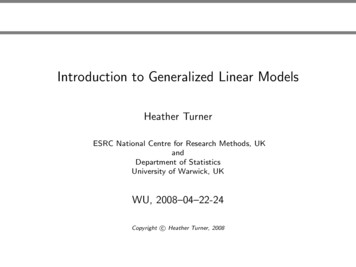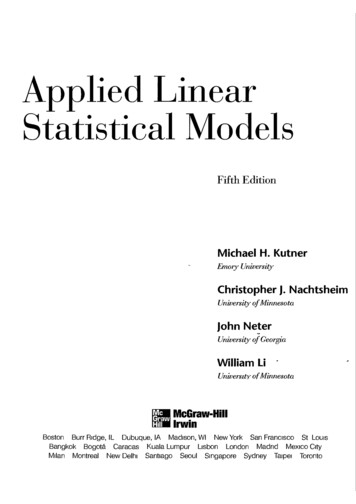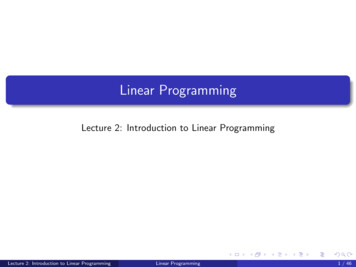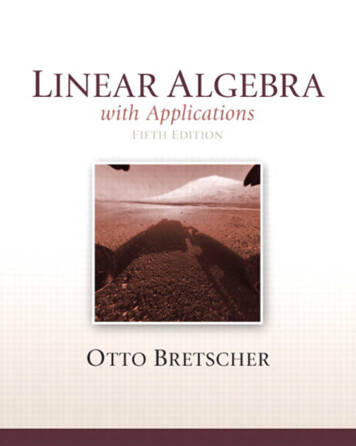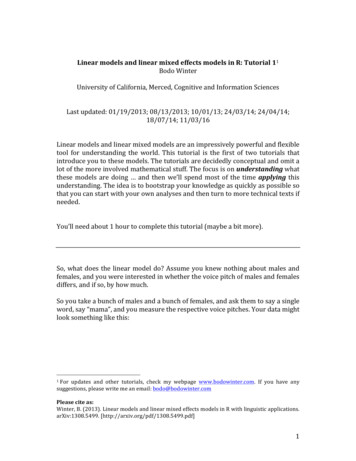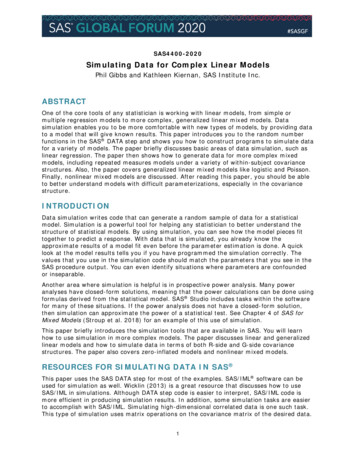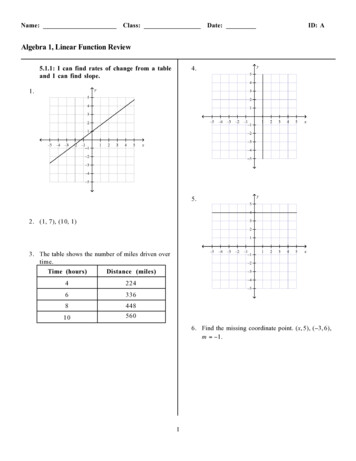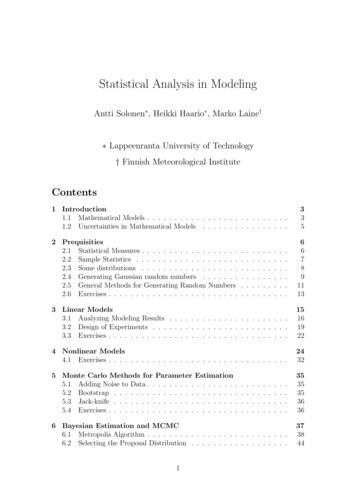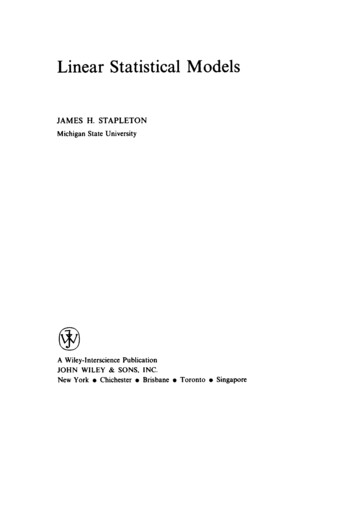
Transcription
Linear Statistical ModelsJAMES H. STAPLETONMichigan State UniversityA Wiley-Interscience PublicationJOHN WILEY & SONS, INC.New York0Chichester0Brisbane0Toronto0Singapore
This Page Intentionally Left Blank
Linear Statistical Models
THE WILEY SERIES IN PROBABILITY AND STATISTICSEstablished by WALTER A. SHEWHART and SAMUEL S . WILKSEditors: Hc Barnert, Ralph A. Uradley, Nicholas I . Fisher, J . Stuart Hunter,J . B. Kadane, David G. Kendall, Dartid W . Scott, Adrian F. '44.Smith,Jozef L. Teugeb. Geofrey S. WatsonA complete list of the titles in this series appears at the end of this volume
Linear Statistical ModelsJAMES H. STAPLETONMichigan State UniversityA Wiley-Interscience PublicationJOHN WILEY & SONS, INC.New York 0 Chichester 0 Brisbane0Toronto0Singapore
This text is printed on acid-free paper.Copyright1995 by John Wiley & Sons, Inc.All rights reserved. Published simultaneously in CanadaReproduction or translation of any part of this work beyondthat permitted by Section 107 or 108 of the 1976 UnitedStates Copyright Act without the permission of the copyrightowner is unlawful. Requests for permission or furtherinformation should be addresscd to the Permissions Department,John Wiley & Sons, Inc., 605 Third Avenue, New York. NY10158-0012.Library of Congress Cm&ging in Publication DataStapleton, James, 1931Linear statistical models 1 James Stapleton.cm. Wiley series in probability andp.statistics. Probability and statistics section)“A Wilcy-Interscience publication.”ISBN 0-471-57150-4 (acid-free)1. Linear models (Statistics)1. Title. 11. Series.Ill. Series: Wiley series in probability andstatistics. Probability and statistics.QA279S6951995519.5’38---d 20W-39384
To Alicia, who, through all the years, never expresseda doubt that this would someday be completed,despite the many doubts of the author.
This Page Intentionally Left Blank
ContentsxiPreface1.Linear Algebra, nVectors, Inner Products, LengthsSubspaces, ProjectionsExamplesSome HistoryProjection OperatorsEigenvalues and Eigenvectors2. Random Vectors2.1. Covariance Matrices2.2. Expected Values of Quadratic Forms2.3. Projections of Random Variables2.4. The Multivariate Normal Distribution2.5. The x2, F, and t Distributions3. The Linear Model3.1.3.2.3.3.3.4.3.5.3.6.3.7.3.8.The Linear HypothesisConfidence Intervals and Tests on q clpl . -. ckPkThe Gauss-Markov TheoremThe Gauss-Markov Theorem for the General CaseInterpretation of Regression CoefficientsThe Multiple Correlation CoefficientThe Partial Correlation CoefficientTesting H,: I3E Vo c Vi1371825293745455053586275758387929597100105vii
viiiCONTENTS3.9.3.10.3.1 1.3.12.3.13.Further Decomposition of SubspacesPower of the F-TestConfidence and Prediction IntervalsAn Example from SASAnother Example: Salary Data4. Fitting of Regression Models4.1.4.2.4.3.4.4.4.5.4.6.4.7.4.8.4.9.4.10.4.1 1.4.12.5.Linearizing TransformationsSpecification Error“Generalized” Least SquaresEffects of Additional or Fewer ObservationsFinding the “Best” Set of RegressorsExamination of ResidualsCollinearityAsymptotic NormalitySpline FunctionsNonlinear Least SquaresRobust RegressionBootstrapping in RegressionSimultaneous Confidence Intervals5.1.5.2.5.3.5.4.5.5.Bonferroni Confidence IntervalsScheffk Simultaneous Confidence IntervalsTukey Simultaneous Confidence IntervalsComparison of LengthsRechhofer’s Method6. Two-way and Three-Way Analyses of Variance6.1.6.2.6.3.6.4.6.5.6.6.Two-way Analysis of VarianceUnequal Numbers of Observations per CellTwo-way Analysis of Variance, One Observation per CellDesign of ExperimentsThree-Way Analysis of VarianceThe Analysis of Covariance7. Miscellaneous Other Models7.1. The Random Effects Model7.2. 0320821322 123023 123223523924 1245245259263265266276283283288
CONTENTS7.3. Split Plot Designs7.4. Balanced Incomplete Block Designs8. Analysis of Frequency bution TheoryConfidence Intervals on Poisson and Binomial ParametersLog-Linear ModelsEstimation for the Log-Linear ModelThe Chi-square StatisticsThe Asymptotic Distributions of fi, & and ALogistic Regressionix29229530430530732433634836637339 1References401Appendix408Answers431Author Index443Subject Index445
This Page Intentionally Left Blank
PrefaceThe first seven chapters of this book were developed over a period of about 20years for the course Linear Statistical Models at Michigan State University.They were first distributed in longhand (those former students may still besuffering the consequences), then typed using a word processor some eight ornine years ago. The last chapter, on frequency data, is the result of a summercourse, offered every three or four years since 1980.Linear statistical models are mathematical models which are linear in theunknown parameters, and which include a random error term. It is this errorterm which makes the models statistical. These models lead to the methodologyusually called multiple regression or analysis of variance, and have wideapplicability to the physical, biological, and social sciences, to agriculture andbusiness, and to engineering.The linearity makes it possible to study these models from a vector spacepoint of view. The vectors Y of observations are represented as arrays writtenin a form convenient for intuition, rather than necessarily as column or rowvectors. The geometry of these vector spaces has been emphasized because theauthor has found that the intuition it provides is vital to the understanding ofthe theory. Pictures of the vectors spaces have been added for their intuitivevalue. In the author’s opinion this geometric viewpoint has not been sufficientlyexploited in current textbooks, though it is well understood by those doingresearch in the field. For a brief discussion of the history of these ideas see Herr( 1980).Bold print is used to denote vectors, as well as linear transformations. Theauthor has found it useful for classroom boardwork to use an arrow notationabove the symbol to distinguish vectors, and to encourage students to do thesame, at least in the earlier part of the course.Students studying these notes should have had a one-year course inprobability and statistics at the post-calculus level, plus one course on linearalgebra. The author has found that most such students can handle the matrixalgebra used here, but need the material on inner products and orthogonalprojections introduced in Chapter 1.xi
xiiPREFACEChapter 1 provides examples and introduces the linear algebra necessary forlater chapters. One section is devoted to a brief history of the early developmentof least squares theory, much of it written by Stephen Stigler (1986).Chapter 2 is devoted to methods of study of random vectors. The multivariate normal, chi-square, t and F distributions, central and noncentral, areintroduced.Chapter 3 then discusses the linear model, and presents the basic theorynecessary to regression analysis and the analysis of variance, including confidence intervals, the Gauss-Markov Theorem, power, and multiple and partialcorrelation coefficients. It concludes with a study of a SAS multiple regressionprintout.Chapter 4 is devoted to a more detailed study of multiple regression methods,including sections on transformations, analysis of residuals, and on asymptotictheory. The last two sections are devoted to robust methods and to thebootstrap. Much of this methodology has been developed over the last 15 yearsand is a very active topic of research.Chapter 5 discusses simultaneous confidence intervals: Bonferroni, Scheffk,Tukey, and Bechhofer.Chapter 6 turns to the analysis of variance, with two- and three-way analysesof variance. The geometric point of view is emphasized.Chapter 7 considers some miscellaneous topics, including random componentmodels, nested designs, and partially balanced incomplete block designs.Chapter 8, the longest, discusses the analysis of frequency, or categoricaldata. Though these methods differ significantly in the distributional assumptionsof the models, it depends strongly on the linear representations, common tothe theory of the first seven chapters.Computations illustrating the theory were done using APL*Plus (Magnugistics, Inc.), S-Plus (Statistical Sciences, Inc.). and SAS (SAS Institute, Inc.).Graphics were done using S-Plus.). To perform simulations, and to producegraphical displays, the author recommends that the reader use a mathematicallanguage which makes it easy to manipulate vectors and matrices.For the linear models course the author teaches at Michigan State Universityonly Section 2.3, Projections of Random Variables, and Section 3.9, FurtherDecomposition of Subspaces, are omitted from Chapters 1, 2, and 3. FromChapter 4 only Section 4. I , Linearizing Transformations, and one or two othersections are usually discussed. From Chapter 5 the Bonferroni, Tukey, andScheffe simultaneous confidence interval methods are covered. From Chapter6 only the material on the analysis of covariance (Section 6.6) is omitted, thoughrelatively little time is devoted to three-way analysis of variance (Section 6.5).One or two sections of Chapter 7, Miscellaneous Other Models, are usuallychosen for discussion. Students are introduced to S-Plus early in the semester,then use it for the remainder of the semester for numerical work.A course on the analysis of frequency data could be built on Sections 1.1,1.2, 1.3, 2.1, 2.2, 2.3, 2.4 (if students have not already studied these topics), and,of course, Chapter 8.
PREFACExiiiThe author thanks Virgil Anderson, retired professor from Purdue University.now a statistical consultant, from whom he first learned of the analysis ofvariance and the design of experiments. He also thanks Professor JamesHannan, from whom he first learned of the geometric point of view, andProfessors Vaclav Fabian and Dennis Gilliland for many valuable conversations.He is grateful to Sharon Carson and to Loretta Ferguson, who showed muchpatience as they typed several early versions. Finally, he thanks the studentswho have tried to read the material, and who found (he hopes) a largepercentage of the errors in those versions.JAMES STAPLETON
This Page Intentionally Left Blank
CHAPTER 1Linear Algebra, Projections1.1 INTRODUCTIONSuppose that each element of a population possesses a numerical characteristicx, and another numerical characteristic y . It is often desirable to study therelationship between two such variables x and y in order to better understandhow values of x affect y, or to predict y, given the value of x. For example, wemay wish to know the effect of amount x of fertilizer per square meter on theyield y of a crop in pounds per square meter. Or we might like to know therelationship between a man's height y and that of his father x.For each value of the independent variable x, the dependent variable Y maybe supposed to have a probability distribution with mean g(x). Thus, forexample, g(0.9) is the expected yield of a crop using fertilizer level x 0.9(k g m s h ).Definition 1.1.1: For each x E D suppose Y is a random variable withdistribution depending on x. Theny(x) E( Ylx)for x E Dis the regression function for Y on xOften the domain D will be a subset of the real line, or even the whole realline. However, D could also be a finite set, say { 1,2,3}, or a countably infiniteset (1,2, . . .}. The experimenter or statistician would like to determine thefunction g, using sample data consisting of pairs ( x i , y i ) for i 1,. . . ,n.Unfortunately, the number of possible functions g(x) is so large that in orderto make headway certain simplifying models for the form of g(x) must beadopted. If it is supposed that g(x) is of the form g(x) A Bx Cx2 org(x) A2" B or &) A log x B, etc., then the problem is reduced to oneof identifying a few parameters, here labeled as A, B, C. In each of the threeforms for g(x) given above, g is linear in these parameters.In one of the simplest cases we might consider a model for which g(x) C Dx, where C and D are unknown parameters. The problem of estimating1
2LINEAR ALGEBRA, ilizer LevelFIGURE 1.1 Regression of yield on fertilizer level.C and D.This model may not be a good approximation of the true regression function,and, if possible, should be checked for validity. The crop yield as a function offertilizer level may well have the form in Figure 1.1.The regression function g would be better approximated by a second degreepolynomial y(x) A Bx Cx2. However, if attention is confined to the 0.7to 1.3 range, the regrcssion function is approximately linear, and the simplifyingmodel y(x) C D.u, called the simple linear regression model, may be used.In attempting to understand the relationship between a person's height Yand the heights of hisiher father (xl) and mother (xZ) and the person's sex (xJ.we might supposeg(x) then becomes the simpler one of estimating the two parameterswhere .x3 is 1 for males, 0 for females, and Po, PI. p2, ps are unknownparameters. Thus a brother would be expected to be P3 taller than his sister.Again, this model, called a multiple regression model, can only be an approximation of the true regression function, valid over a limited range of values ofx l , x2. A more complex model might suppose
3VECTORS, lNNER PRODUCTS, LENGTHSTable 1.1.1Indiv.12345678910Height 0This model is nonlinear in (xl, x2, x3), but linear in the Fs. It is the linearityin the p's which makes this model a linear statistical model.Consider the model ( l . l . l ) , and suppose we have data of Table 1.1.1 on( Y , x , , x z , x 3 ) for 10 individuals. These data were collected in a class taughtby the author. Perhaps the student can collect similar data in his or her classand compare results.b,, &, b, so that theThe statistical problem is to determine estimatesresulting function d(x,, x2, x3) B,x, B2x2 B,x3 is in some sense agood approximation of g(x,, x2, x3). For this purpose it is convenient to writethe model in vector form:Po b0, where xo is the vector of all ones, and y and xlr x2, x3 are the column vectorsin Table 1.1.1.This formulation of the model suggests that linear algebra may be animportant tool in the analysis of linear statistical models. We will thereforereview such material in the next section, emphasizing geometric aspects.1.2 VECTORS, INNER PRODUCI'S, LENGTHSLet R be the collection of all n-tuples of real numbers for a positive integer n.In applications R will be the sample space of all possible values of theobservation vector y. Though 2 will be in one-to-one correspondence toEuclidean n-space, it will be convenient to consider elements of Q as arrays allof the same configuration, not necessarily column or row vectors. For example,in application to what is usually called one-way analysis of variance, we might
4LINEAR ALGEBRA. PROJECTIONShave 3,4 and 2 observations on three different levels of some treatment effect.Then we might takeYlZYzzY32)14 Zand 0 the collection of all such y- While we could easily reform y into a columnvector, it is often convenient to preserve the form of y. The term "n-tuple"means that the elements of a vector y f R are ordered. A vector y may beconsidered to be a real-valued function on { 1,. . .,n } .R becomes a linear space if we define ay for any y E R and any real numbera to be the element of R given by multiplying each component of R by a, andif for any two elements yl, yz E R we define yl yz to be the vector in R whoseith component is the sum of the ith components of y, and y2, for i 1, . . . , n.R becomes an inner product space if for each x, y E R we define the functionwhere x ( x l , . . , x n ) and y { y , , . . . , y . ) . If R is the collection of ndimensional column vectors then h(x, y) x'y, in matrix notation. The innerproduct h(x, y) is usually written simply as (x, y), and we will use this notation.The inner product is often called the dot product, written in the form x - y . Sincethere is a small danger of confusion with the pair (x, y), we will use boldparentheses to emphasize that we mean the inner product. Since bold symbolsare not easily indicated on a chalkboard or in student notes, it is importantthat the meaning will almost always be clear from the context. The innerproduct has the properties:for all vectors, and real numbers a.We define \lx\\' (x, x) and call llxll the {Euclidean) length of x. Thusx (3,4, 12) has length 13.The distance between vectors x and y is the length of x - y. Vectors x andy are said to be orthogonal if (x, y) 0. We write x Iy.
5VECTORS, MNER PRODUCTS, LENGTHSFor example, if the sample space is the collection of arrays mentioned above,thenare orthogonal, with squared lengths 14 and 36. For R the collection of 3-tuples,(2,3, 1) I (- I , 1, - 1).The following theorem is perhaps the most important of the entire book.We credit it to Pythagorus (sixth century B.c.), though he would not, of course,have recognized it in this form.Pythagorean Tbeorem: Let v,, . . . ,vk be mutually orthogonal vectors in RThenDebition 1.21:such thatThe projection of a vector y on a vector x is the vector 91. 9 bx for some constant b2. (y - 5) I x (equivalently, (9, x) (y, x))Equivalently, 3 is the projection of y on the subspace of all vectors of the formax, the subspace spanned by x (Figure 1.2). To be more precise, these propertiesdefine othogonal projection. We will use the word projection to mean orthogonal projection. We write p(ylx) to denote this projection. Students shouldnot confuse this will conditional probability.Let us try to find the constant b. We need (9, x) (bx, x) b(x, x) (y, x).Hence, if x 0, any b will do. Otherwise, b (y, x)/[lxl12. Thus,[(y,X)/IIXI( ]X,for x 0otherwiseHere 0 is the vector of all zeros. Note that if x is replaced by a multiple ax ofx, for a # 0 then 9 remains the same though the coefficient 6 is replaced by 6/a
6LINEAR ALGEBRA, PROJECTIONSAYXFIGURE 1.2Theorem 1.2.1: Among all multiples ux of x, the projectionthe closest vector to y.9 of y on xisProof: Since (y - 9) I ( 9 - ax) and (y - ax) (y - 9 ) (9 - ax), itfollows that11y- ax112 !(y - 11’This is obviously minimum for ux 9. iI - uxI12.I1Since 3 I (y - 9) and y 9 (y - 9), the Pythagorean Theorem implies, impliesthat IIyilz 11911’ I/y - 9112. Since [19iI2 b211xIIZ (y, X ) / I I X I I this\ , equality if and only if Ily - 911 0, i.e., y is athat !Iyilz 2 (y, ) / l l x lwithmultiple of x. This is the famous Cauchy-Schwurz Inequality, usually writtenas (y, x ) Illy112/1x112.The inequality is best understood as the result of theequality implied by the Pythagorean Theorem.Definition 1.2.2: Let A be a subset of the indices of the components of avector space R. The indicator of A is the vector I, E !2, with components whichare 1 for indices in A, and 0 otherwise.The projection 9, of y on the vector I, is therefore hl, for b (y. I , ) / l l k 2(2y[)/N(A),where N ( A ) is the number of indices in A. Thus, h j A , the
7SUBSPACES, PROJECTIONSmean of the y-values with components in A. For example, if R is the space of4-component row vectors, y (3,7,8,13), and A is the indicator of the secondand fourth components, p(yl1,) (0,10, 0,lO).)Problem 1.2.1: Let R be the collection of all 5-tuples of the formy (‘”).Letx (”211 0).y (’2 1 39 4 11(a) Find (x, y), I I X Ilyl12, , 9 p(yIx), and y - 9. Show that x I(y - j ) , andYlZIIYII’ Y22y.31119112 IIY - 911’.(-21)and z 3x 2n. Show that (w, x) 0 and that0 2 01!z)1’ 911x)j’ 4[1wl12.(Why must this be true?)(c) Let x,, x‘, x3 be the indicators of the first, second and third columns.Find p(y)x,) for i 1, 2, 3.(b) Let w Problem 12.2: Is projection a linear transformation in the sense thatp(cyIx) cp(ylx) for any real number c? Prove or disprove. What is therelationship between p(y(x) and p(yicx) for c # O?Problem 1.23: Let l1x11’ 0. Use calculus to prove that I/y - hxII’ isminimiim for b (y, x)/IIxlI’.IIxProblem 134: Prove the converse of the Pythagorean Theorem. That is, yi12 llxll’ illyll’ implies that x 1y.Problem 1.2.5:1.3Sketch a picture and provc the parallelogram law:SUBSPACES, PROJECTIONSWe begin the discussion of subspaces and projections with a number ofdefinitions of great importance to our subsequent discussion of linear models.Almost all of the definitions and the theorems which follow are usually includedin a first course in matrix or linear algebra. Such courses do not always includediscussion of orthogonal projection, so this material may be new to the student.Defioition 1.3.1: A subspuce of R is a subset of R which is closed underaddition and scalar multiplication.That is, V c R is a subspace if for every x E V and every scalar a, ax E Vand if for every vl, v2 E V, vI v2 E V.
8LINEAR ALGEBRA. PROJECTIONSDefinition 1.3.2: Let xl,. . . ,x k be k vectors in an n-dimensional vectorspace. The subspace spanned by x , , . . . ,x k is the collection of all vectorsfor all real numbers b,, . . . ,bk. We denote this subspace by Y ( x , , . . . , x k ) .Definition 133: Vectors x , , . . . ,x k are linearly independent ifimplies b, 0 for i 1,. . . ,k.t1bixi OIDefinition 13.4: A busis for a subspace V of f2 is a set of linearlyindependent vectors which span V .The proofs of Theorems 1.3.1 and 1.3.2 are omitted. Readers are referred toany introductory book on linear algebra.Tbeorem 1.3.1: Every basis for a subspace V on 2 has the same numberof elements.Definition 13.5: The dimension of a subspace Y of Q is the number ofelements in each basis.Theorem 13.2: Let v,, . . . ,vk be linearly independent vectors in a subspaceV of dimension J . Then d 2 k.Comment: Theorem 1.3.2 implies that if dim( V) d then any collection ofd 1 or more vectors in V must be linearly dependent. In particular, anycollection of n 1 vectors in the n-component space R are linearly dependent.Definition 13.6: A vector y is orthogonal to a subspace V of Q if y isorthogonal to all vectors in V. We write y L V.Problem 1.3.1: Let Q be the space of all 4component row vectors.Let x 1 ( 1, 1, 1, 1), X I ; (1, 1,0, O), 3 (1,0, 1,0), 4 (7,4,9,6). Let Vz V ( x 1 ,X A Vs Y(x,, 2 x j, ) and V, Y ( x 1 , 2 r 3 9 4 ) .(a) Find the dimensions of Vz and V,.which contain vectors with as many zeros as(b) Find bases for V2 andpossible.(c) Give a vector z # 0 which is orthogonal to all vectors in V,.(d) Since x l , x2, xg, z are linearly independent, x4 is expressible in the form31b,xi cz. Show that c 0 and hence that x4 E V,, by determining ( x 4 ,2).What is dim( V,)?(e) Give a simple verbal description of V3.
[:::SUBSPACES. PROJECTIONS9Y2,Problem 13.2: Consider the space R of arrays y , 2 y,,and defineC,,C2.C3to be the indicators of the columns. Let V Y ( C , ,Cz,C3).(a) What properties must y satisfy in order that y E M In order that y IM(b) Find a vector y which is orthogonal to V.The following definition is perhaps the most important in the entire book.It serves as the foundation of all the least squares theory to be discussed inChapters 1, 2, and 3.Definition 1.3.7: The projection of a vector y on a subspace Y of R is thevector 9 E V such that (y - 9) I V. The vector y - 9 e will be called theresidual vector for y relative to V.Comment: The condition (y - 9 ) 1 V is equivalent to (y - f, x) 0 for allx E V . Therefore, in seeking the projection f of y on a subspace V we seek avector 9 in V which has the same inner products as y with all vectors in V(Figure 1.3).If vectors x,. . . . ,x k span a subspace V then a vector z E V is the projectionckof y on V if (z, x i ) (y. x i ) for all i, since for any vector x implies thatj-bjxlEV, this1It is tempting to attempt to compute the projection f of y on V by simplysumming the projections f i p(yIx,). As we shall see, this is only possible insome very special cases.FIGURE 13
10LINEAR ALGEBRA, PROJECTIONSAt this point we have not established the legitimacy of Definition 1.3.7. Doessuch a vector 9 always exist and, if so, is it unique? We do know that theprojection onto a one-dimensional subspace, say onto V 9(x), for x # 0,does exist and is unique. In factExample 13.1:Consider the 6-component space Q of the problem above,i6and let V 2(Cl,C2,C3). Let y 10 8\ s7\. It is easy to show that theJvector 9 Ep(yJC,) 7C1 6C2 7C3 satisfies the conditions for a projection onto V. As will soon be shown the representation of f as the sum ofprojections on linearly independent vectors spanning the space is possiblebecause C,,C,, and C3 are mutually othogonal.We will first show uniqueness of the projection. Existence is more difficult.Suppose 9 , and g2 are two such projections of y onto V. Then f 1- 9, E V and(9, - 9,) (y - 9,) - (y - fl)is orthogonal to all vectors in V , in particularto itself. Thus llf, - 9,112 (PI - y,, 9, - jl,) 0, implying - f2 0, i.e.,9, 92.We have yet to show that 4 always exists. In the case that it does exist (wewill show that it always exists) we will write 9 p(yl Vj.If we are fortunate enough to have an orthogonal basis (a basis of mutuallyorthogonal vectors) for a given subspace V, it is easy to find the projection.Students are warned that that method applies only for an orthogonal basis. Wewill later show that all subspaces possess such orthogonal bases, so that theprojection 9 p(yl V) always exists.Theorem 133: Let v,, . . . ,vk be an orthogonal basis for V, subspace of R.ThenPOIkv) iCP(YIvi) 1Proof: Let fi p(ylv,) hivi for hi (y, vi)/Ilvi112. Since 3,- is a scalarmultiple of vi, it is orthogonal to vj forj # i.From the comment on the previousand y, have the same inner product withpage, we need only show thateach vj, since this implies that they have the same inner product with all x E V.Butcfi
11SUBSPACES, PROJECTIONSExample 13.2:LetThen v1 I v2 andThen (y, v l ) 9, (y, v2) 12, (9, vl) 9, and (9, v,) 12. The residual vector isy-9 /-o\which is orthogonal to V.Would this same procedure have worked if we replaced this orthogonal basisv!, v1 for Y by a nonorthogonal basis? To experiment, let us leave v, in thenew basis, but replace v2 by v3 2v, - v2. Note that lip(vl, v3) 9 ( v I , v2) V,and that (v,, v2) # 0. f I remains the same. v3 2v, - v2 , which has inner products 11 and 24 with v1 and v3.is not orthogonal to V. Therefore, 9, j 3 is not theprojection of y on V Y ( v l , v3).Since (y - 9) I 9, we have, by the Pythagorean Theorem,l!Y!I2 IKY - 9 ) HI2 IlY - 9112 1191r’llyllz 53,11f112 92123 6 51,IIy- j1I2 I(-‘)i2 2.1Warning: We have shown that when v l , . .,vk are mutually orthogonal
12LINEAR ALGEBRA, PROJECTIONSthe projection 3 of y on the subspace spanned by vl, . . . ,vk isk/ 1p(y(vj). Thisis true for all y only if vI, . . . ,vk are mutually orthogonal. Students are askedto prove the “only” part in Problem 1.3.5.Every subspace V of R of dimension r 0 has an orthogonal basis (actuallyan infinity of such bases). We will show that such a basis exists by usingGram-Schmidt orthogonalization.Let xl,. . . ,xk be a basis for a subspace V, a kdimensional subspace of Q.For 1 5 i 5 k let 6 U(xl, . . . ,xi) so that V, c 6 t * * c 5 are properlynested subspaces. Letv1 Xl,v2 x2- p(X,lV,). Then vl and v2 span 6 and are othogonal. Thus p(x3( V,) p(x,lv,)p(x31v2)and we can define v3 x3 - p(x3JVz).Continuing in this way, suppose we havedefined vl, ., vi to be mutually orthogonal vectors spanning 6. Definevi l xi , - ( X Jo. ThenIvi l 1 and hence v,, . .,vi I are mutuallyorthogonal and span c l. Since we can do this for each i Ik - 1 we get theorthogonal basis vl,. . . ,vk for V.If {vl,. . . ,v k } is an orthogonal basis for a subspace V then, since f 2 p(ylv,)kP(yl V ) j- 1and p(ylvj) bjvj, with b, [(y, v,)/IIvjl12],it follows bythe Pythagorean Theorem thatkkkOf course, the basis {vl,. . . ,vk) can be made into an orthonormal basis (allvectors of length one) by dividing each by its own length. If {v:, . . . ,v:) is suchan orthonormal basis thencki 13 p(yl V ) kk1p(ylv’) C (y. vf)vf1and11911’ (YN2.[ \ ,: ’ ],E x a m p l e 1.3.3: Consider R,, the space of Ccomponent column vectors.Let us apply Gram--Schmidt orthogonalization to the columns of X a matrix chosen carefully by the author to keep the5810
13SUBSPACES, PROJECTIONSarithmetic simple. Let the four columns be xlr. , x4. Define v 1 xl. Let,v 3 x 3 - [ r * , * 6 v322 ] -22L -2.andWe can multiply these vI by arbitrary constants to simplify them without losingtheir orthogonality. For example, we can define ui vi/l vil12, so that u,, u2,u3, u, are unit length orthogonal vectors spanning R. Then U (ul, u2, u3,u4)is an orthogonal matrix. U is expressible in the form U XR, where R haszeros below the diagonal. Since I U'U U'XR, R - U'X, and X UR- ',where R-' has zeros below the diagonal (see Section 1.7).'As we consider linear models we will often begin with a model whichsupposes that Y has expectation 8 which lies in a subspace b,and will wishto decide whether this vector lies in a smaller subspace V,. The orthogonalbases provided by the following theorem will be useful in the development ofconvenient formulas and in the investigation of the distributional properties ofestimators.Theorem 1.3.4: Let V, c V, c R be subspaces of Q of dimensions1 5 n, c n, c n. Then there exist mutually orthogonal vectors vl, . . . ,v, suchthat vI,. . . , v,, span F, i 1, 2.Proof: Let {xl,. .,x,,} be a basis for V,. Then by Gram-Schmidtorthogonalization there exists an orthogonal basis (vl,. . . ,v,,} for V,. Letx,, l , . . . ,xnZbe chosen consecutively from V2 so that vI, . . . ,v,,,, x,,, . . ,
Stapleton, James, 1931- Linear statistical models 1 James Stapleton. p. cm. Wiley series in probability and statistics. Probability and statistics section) "A Wilcy-Interscience publication." ISBN -471-57150-4 (acid-free) 1. Linear models (Statistics) 1. Title. 11. Series. Ill. Series: Wiley series in probability and statistics.

